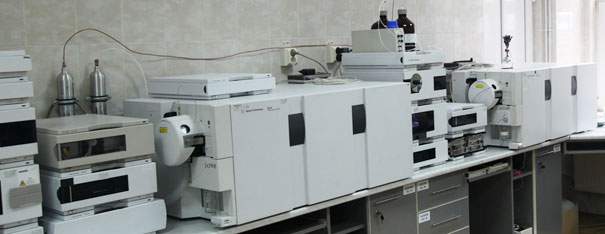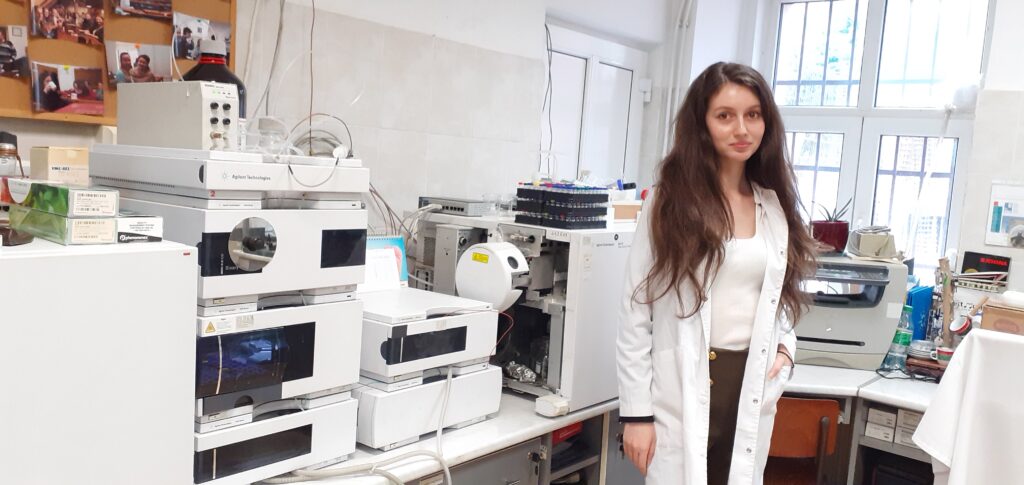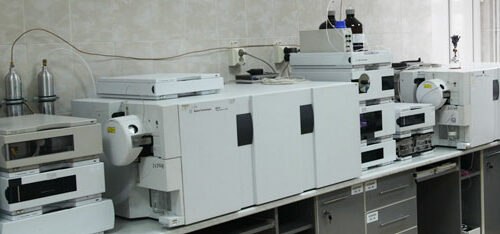Enzymology and Applied Biocatalysis Research Center
Biocatalysis stands out as one of the core strategies within the Principles of “Green Chemistry,” a crucial pillar of the sustainable development, aimed at supplanting Classical Chemistry as the dominant paradigm. The foundation of biocatalysis is the integration of enzymes as catalysts, harnessing their promiscuity, either within exclusive biotransformation pathways or hybrid synthetic-enzymatic systems. Enzymes, as versatile catalysts, enable effective and extremely selective biotransformations, while remaining easily biodegradable and environmentally friendly. These biocatalyts operate in aqueous media, at ambient temperature and normal pressure, thereby minimizing the energy consumption of the overall process. In particular, the growing demand for enantiopure compounds, most notably as pharmacophores, has propelled the widespread application of biocatalysts at industrial scale, due to their remarkable selectivity far surpassing that of conventional chemocatalysts. The study of enzyme-catalyzed processes at the molecular level is a dynamically evolving field, propelled by recent advancements in molecular genetics, structural biology, and bioinformatics, which have facilitated the more prevalent creation of tailored enzymes capable of transforming both natural and non-natural analogues.
To explore the synthetic scope of biocatalysis, the Enzymology and Applied Biocatalysis Research Center aims to design novel biocatalyst variants that access new chemistry by protein engineering and further develop optimized scale-up processes engaging both native and mutated enzymes. The Group’s portfolio comprises of a vast array of enzyme classes including lipases, esterases, oxidoreductases, aromatic ammonia-lyases and aminomutases, ω-transaminases, carboxylic acid decarboxylases and the human carbonic anhydrase. The research topics are extremely diverse, from protein engineering techniques to batch and flow processes implementation.
The research activity at the Enzymology and Applied Biocatalysis Research Center is aimed at:
- Enzyme engineering through rational design and semi-rational directed evolution-based techniques, including CASTing (Combinatorial Active site Saturation Test (CAST) and ISM (Iterative Saturation Mutagenesis) focused to increase either the thermostability or the activity towards non-natural substrates.
- High-throughput enzyme assay developments for easy handling and facile visual detection of mutant libraries derived from the semi-rational approaches, for qualitative and quantitative solid-phase or liquid-phase identification.
- Enzyme immobilization achieved through various techniques involving covalent bonding, entrapment, encapsulation, and more recently, site-specific immobilization through non-natural amino acid incorporation or thiol-maleimide coupling.
- Lipase-mediated kinetic resolution (KR) and click-reaction-based downstream procedures.
- Refinement of enzymatic/multi-enzymatic and chemoenzymatic cascades, in order to attain optimal performance for the large-scale biocatalytical production of synthetically valuable compounds: l-phenylalanine analogues, d-phenylalanine analogues, (S)-alcohols, 1,2-diols, (S)/(R)-amines, (R)-acyloins or fatty acid diesters useful products to improve the cetane number of biodiesel.
- Batch, continuous-flow, micro-flow enzymatic and/or chemoenzymatic processes adapted for immobilised enzymes.
Analysis and characterization of organic compounds, inclusive from complex mixtures (biological samples). Equipped with specific software and databases as well as the necessary auxiliar instrumentation for sample processing. The LC/MS system can be used to identifiy and/or quantitate trace organic compounds in complex matrices. Main area of use being food safety studies, environmental studies, drug discovery, toxicology, forensics, process monitoring.
The HPLC system is equipped with thermostatted [4-40 °C] autosampler, with tray capacity of 100 samples. For good mobile phase composition accuracy the system is equipped with binary pumps, for method development also quaternary pump can be used.
The detection of analytes can be performed with VWD, DAD, MWD, FLD and RID detectors.
For better detection sensitivity, and high specificity the triple quad mass spectrometer is used (m/z up to 2k).
Chiral separations can be perfomed in normal (no MS detection possible) and reverse phase mode.
The system is equipped with electrospray ionisation source (ESI), providing good sensitivity for high and medium polarity organic molecules with ionisable functional groups.
Using rapid resolution columns an analytical throughput of 500-600 samples/day/LC-MS system can be achieved.
MassHunter software platform is used for instrument control, qualitative- and quantitative analysis. Reports are generated in pdf, xls or html formats depending on user request.
If analyses are to performed according to GLP, ISO, ICH, etc. guidelines, full audit trail (traceability) can be provided.


Access policy and costs
- molecular cloning; protein engineering; recombinant protein expression in E. coli, protein isolations/purifications
- enzyme activity / protein stability assesments
- protein-labeling, development of protein-ligand conjugates
- biocatalyst engineering for requested biotransformations
- development of robust, immobilized biocatalysts dedicated for requested reactions
- gram-scale production of optically pure aromatic secondary alcohols, amines, diols, β-hydroxycarboxy acids, acyloins and their derivatives, aromatic α- and β- amino acids
- qualitative and quantitative analysis of complex organic mixtures, including biological extracts
- method-development for stereoselective synthesis of chiral organic compounds
- The services are part of the research services offered by the InfraChem-FCIC infrastructure platform of the Faculty of Chemistry and Chemical Engineering (FCIC) at Babes-Bolyai University. (erris.gov.ro/InfraChem-FCIC)
Contact person
Arany Janos street 11, 400028
web: http://www.chem.ubbcluj.ro/BIO/CENTRU/
- Prof. Habil. Dr. Eng. Paizs Csaba, csaba.paizs@ubbcluj.ro
- Prof. Habil. Dr. Eng. Monica Ioana Toșa, monica.tosa@)ubbcluj.ro
- Assoc. Prof. Dr. Bencze László Csaba, laszlo.bencze@ubbcluj.ro
Research and publications
- 1. Balogh-Weiser D., Decsi B., Krammer R., Dargó G., Ender F., Mizsei J., Berkecz R., Gyarmati B., Szilágyi A., Tőtős R., Paizs C., Poppe L., Balogh G.T., Magnetic nanoparticles with dual surface functions—efficient carriers for metalloporphyrin-catalyzed drug metabolite synthesis in batch and continuous-flow reactors, Nanomaterials (2020) 10(12): 2329, DOI:10.3390/nano10122329.
- 2. Spelmezan C.G., Bencze L.C., Katona G., Irimie F.D., Paizs C., Toşa M.I., Effcient and stable magnetic chitosan-lipase B from candida antarctica bioconjugates in the enzymatic kinetic resolution of racemic heteroarylethanols, Molecules (2020) 25(2): 350, DOI: 10.3390/molecules25020350.
- 3. Nagy-Győr L., Farkas E., Lăcătuș M., Tóth G., Incze D., Hornyánszky G., Bódai V., Paizs C., Poppe L., Balogh-Weiser D., Conservation of the biocatalytic activity of whole yeast cells by supported sol – gel entrapment for efficient acyloin condensation, Periodica Polytechnica Chemical Engineering (2020) 64(2): 153-161, DOI: 10.3311/PPch.14645.
- 4. Tomoiagă R.B., Tork S.D., Horváth I., Filip A., Nagy L.C., Bencze L.C., Saturation mutagenesis for phenylalanine ammonia lyases of enhanced catalytic properties, Biomolecules (2020) 10(6): 838, DOI: 10.3390/biom10060838.
- 5. Moisă M.E., Amariei D.A., Nagy E.Z.A., Szarvas N., Toşa M.I., Paizs C., Bencze L.C., Fluorescent enzyme-coupled activity assay for phenylalanine ammonia-lyases, Scientific Reports (2020) 10(1): 18418, DOI: 10.1038/s41598-020-75474-y.
- 6. Lǎcǎtuş M.A., Dudu A.I., Bencze L.C., Katona G., Irimie F.-D., Paizs C., Toşa M.I., Solvent-Free Biocatalytic Synthesis of 2,5-bis-(Hydroxymethyl)Furan Fatty Acid Diesters from Renewable Resources, ACS Sustainable Chemistry and Engineering (2020) 8(3): 1611-1617, DOI: 10.1021/acssuschemeng.9b06442.
- 7. Dulf F.V., Vodnar D.C., Toşa M.I., Dulf E.-H., Simultaneous enrichment of grape pomace with γ-linolenic acid and carotenoids by solid-state fermentation with Zygomycetes fungi and antioxidant potential of the bioprocessed substrates, Food Chemistry (2020) 310: 125927, DOI: 10.1016/j.foodchem.2019.125927.
- 8. Varga A., Csuka P., Sonesouphap O., Bánóczi G., Toşa M.I., Katona G., Molnár Z., Bencze L.C., Poppe L., Paizs C., A novel phenylalanine ammonia-lyase from Pseudozyma antarctica for stereoselective biotransformations of unnatural amino acids, Catalysis Today (2021) 366: 185-194, DOI: 10.1016/j.cattod.2020.04.002.
- 9. Bata Z., Molnár Z., Madaras E., Molnár B., Sánta-Bell E., Varga A., Leveles I., Qian R., Hammerschmidt F., Paizs C., Vértessy B.G., Poppe L., Substrate Tunnel Engineering Aided by X-ray Crystallography and Functional Dynamics Swaps the Function of MIO-Enzymes, ACS Catalysis (2021) 11(8): 4538-4549, DOI: 10.1021/acscatal.1c00266.
- 10. Dudu A.I., Lacatus M.A., Bencze L.C., Paizs C., Tosa M.I., Green Process for the Enzymatic Synthesis of Aroma Compounds Mediated by Lipases Entrapped in Tailored Sol-Gel Matrices, ACS Sustainable Chemistry and Engineering (2021) 9(15): 5461-5469, DOI: 10.1021/acssuschemeng.1c00965
- 11. Boros K., Moisǎ M.E., Nagy C.L., Paizs C., Toşa M.I., Bencze L.C., Robust, site-specifically immobilized phenylalanine ammonia-lyases for the enantioselective ammonia addition of cinnamic acids, Catalysis Science and Technology (2021) 11(16): 5553-5563, DOI: 10.1039/d1cy00195g.
- 12. Gal C.A., Barabás L.E., Bartha-Vári J.-H., Moisă M.E., Balogh-Weiser D., Bencze L.C., Poppe L., Paizs C., Toșa M.I., Lipase on carbon nanotubes – an active, selective, stable and easy-to-optimize nanobiocatalyst for kinetic resolutions, Reaction Chemistry & Engineering (2021) 6Ș2391-2399, DOI: 10.1039/D1RE00342A.
- 13. Scrob, D.M., Lăcătuș, M.A., Dudu, A.I., Eco-friendly enzymatic synthesis of anisyl propionate mediated by lipase b from candida antarctica, Studia Universitatis Babes-Bolyai Chemia, 2021, 66(2), 277–286, DOI: 10.24193/subbchem.2021.2.24.
- 14. Bata Z., Molnár Z., Madaras E., Molnár B., Sánta-Bell E., Varga A., Leveles I., Qian R., Hammerschmidt F., Paizs C., Vértessy B. G., Poppe L., Substrate Tunnel Engineering Aided by X-ray Crystallography and Functional Dynamics Swaps the Function of MIO-Enzymes, ACS Catalysis (2021) 11(8):4538–4549, DOI: 10.1021/acscatal.1c00266.
- 15. Csuka P., Nagy-Győr L., Molnár Z., Paizs C., Bódai V., Poppe L., Characterization of yeast strains with ketoreductase activity for bioreduction of ketones, Periodica Polytechnica Chemical Engineering (2021) 65(3):299–307, DOI: 10.3311/PPch.17429.
- 16. Tork S.D., Moisă M.E., Cserepes L., Filip Alina, Nagy Levente Csaba, Irimie F.D., Bencze L.C., Towards a general approach for tailoring the hydrophobic binding site of phenylalanine ammonia-lyases, Scientific Reports (2022) 12(1):10606, DOI: 10.1038/s41598-022-14585-0.
- 17. Duță H., Filip A., Nagy L.C., Nagy E. Z. A., Tőtős R., Bencze L.C., Toolbox for the structure-guided evolution of ferulic acid decarboxylase (FDC), Scientific Reports (2022) 12(1):3347, DOI: 10.1038/s41598-022-07110-w.
- 18. Gal C.A., Barabás L.-E., Varga A., Csuka P., Bencze L. C., Toșa M. I., Poppe L., Paizs C., How to identify and characterize novel transaminases? Two novel transaminases with opposite enantioselectivity for the synthesis of optically active amines, Molecular Catalysis (2022) 531: 112660, DOI: 10.1016/j.mcat.2022.112660.
- 19. Dudu, A.I., Bencze, L.C., Paizs, C., Toşa, M.I., Deep eutectic solvents-a new additive in the encapsulation of lipase B from: Candida antarctica: Biocatalytic applications, Reaction Chemistry and Engineering (2022) 7(2):442–449, DOI: 10.1039/d1re00469g.
- 20. Nagy F., Sánta-Bell E., Jipa M., Hornyánszky G., Szilágyi A., László K., Katona G., Paizs C., Poppe L., Balogh-Weiser D., Cross-Linked Enzyme-Adhered Nanoparticles (CLEANs) for Continuous-Flow Bioproduction, ChemSusChem (2022), 15(2): e202102284, DOI:10.1002/cssc.202102284.

